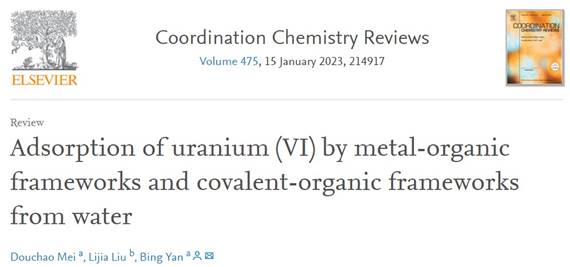As we all know, energy and the environment are two everlasting themes for the development of society. Nuclear energy has attracted wide attention in recent years due to its advantages such as low operating cost, convenient transportation and environmental friendliness. As the main nuclear fuel, uranium is much more abundant in seawater than on land, so it is essential to extract uranium from seawater. Besides, uranium-containing wastewater discharged by the nuclear industry also poses a serious threat to the ecological environment. Professor Yan Bing has long been dedicated to the synthesis and application of metal-organic frameworks (MOFs) and covalent-organic frameworks (COFs). Recently, the research team of Professor Yan Bing published a paper titled "Adsorption of Uranium (VI) by Metal-organic Frameworks and Covalent-organic Frameworks from Water" in Coordination Chemistry Reviews, an internationally renowned journal, systematically summarizing the application of MOFs and COFs in uranium extraction from seawater and uranium removal from wastewater.

In the paper, firstly, the different synthesis methods of MOFs and COFs are summarized, such as the solvothermal method, steam diffusion method, microwave method, ultrasonic method, and mechanical grinding method. Then, the effects of various factors (pH, initial uranium concentration, amount of adsorbent, temperature, time, ionic strength, coexisting ions, etc.) on uranium adsorption are investigated separately, and the practical application potential of MOFs and COFs in the field of uranium adsorption is evaluated. Next, the bonding mechanism of MOFs/COFs and UO22+ is analyzed from thermodynamics, kinetics, coordination environment, DFT theoretical calculation, etc. Finally, the adsorption properties of MOFs/COFs to uranium are compared with other materials. The results show that MOFs/COFs are promising uranium adsorbents.

On this basis, the author creatively proposes to apply the RNN model to the detection and adsorption of U(VI) by MOFs/COFs. The deep machine learning algorithm can replace the use of inductively coupled plasma optical emission spectrometry (ICP-OES), that is, the concentration of uranyl ions in solution can be calculated by the change of fluorescence intensity, which provides a reference for the future application of MOFs and COFs in the field of uranium adsorption.

Mei Douchao, a doctoral student enrolled in 2022, is the first author of the paper, and Professor Yan Bing is the corresponding author of the paper. The research was funded by the National Natural Science Foundation of China